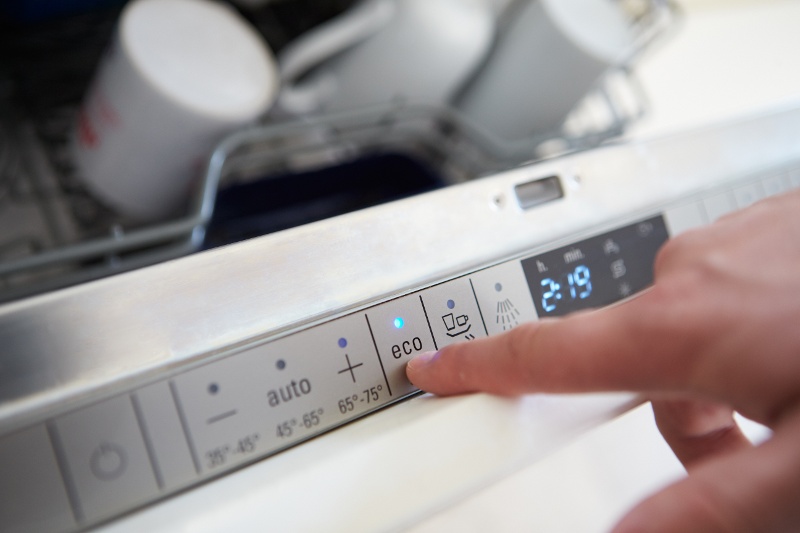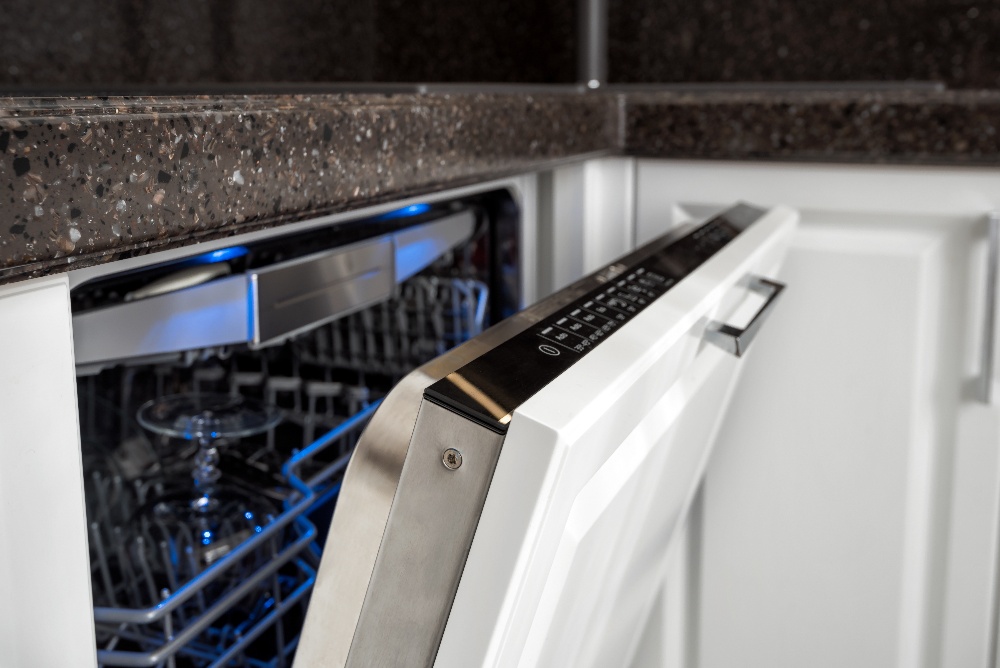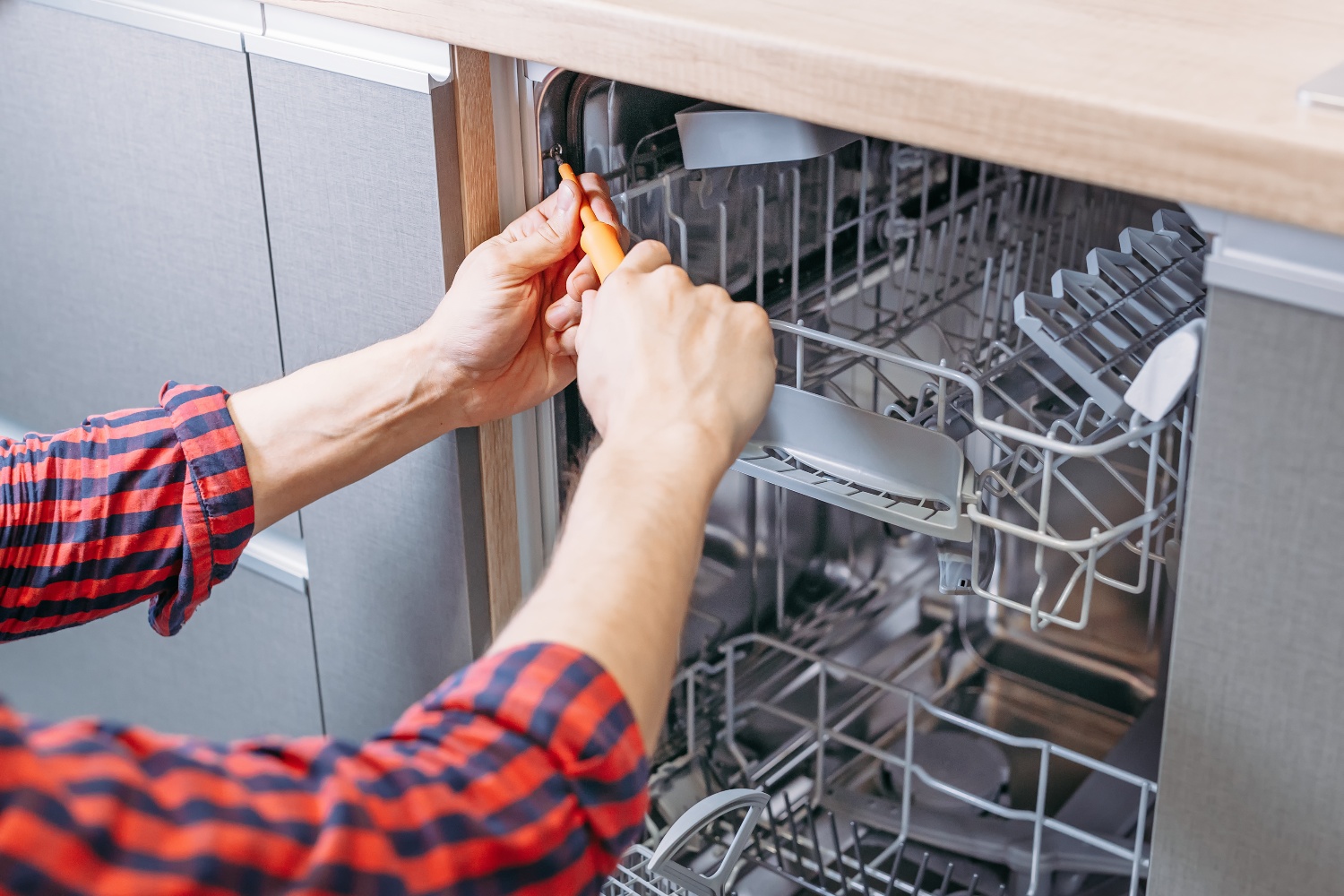When Josephine Garis Cochran invented the first practical dishwasher in 1886, she did so to solve a problem. She wanted a machine that could wash dishes faster than they could be done by hand and without breaking them.
When she couldn't find one, the founder of KitchenAid built one. How's that for ingenuity?
Josephine was definitely onto something that revolutionized how a time-consuming chore was done. At this point, you've probably become pretty reliant on your dishwasher to make short work of your kitchen clean-up.
How Do Dishwashers Operate?
We all have a basic knowledge of how our dishwashers work, but have you ever really understood what happens when you close that door and push that start button? The mystery is solved:
- Water enters through pipes and fills the dishwasher’s bottom basin.
- Upper and lower spray arms spin and deposit water over the dishes as a pre-wash.
- Depending on the wash setting you’ve chosen, the internal water is heated to the proper temperature.
- The cycle is controlled by a timer. When appropriate, the detergent door opens and releases the cleaner into the appliance.
- Rotating spray arms spread pressurized hot water and detergent over the dishes to clean off food particles and other debris. A filter will catch small pieces while larger debris is chopped up and removed similar to a disposal.
- Clear water rinses the dishes and deposits back to the basin.
- Once the wash cycle is complete, the dirty water drains out through the pipes or garbage disposal.
- If you’ve chosen a dry cycle, the heating element will warm the air inside the dishwasher, evaporate the water and dry the dishes. To save energy, you can elect to air dry them.
Common Dishwasher Problems
There are a number of common dishwasher problems that can arise. In many cases, the issue is easily corrected, so before you contact a repair service, consider these fixes:
-
Dishes are not Drying or Have Puddling Water
Have you been using rinse aid? If not, you’ll want to get some. This product is activated when the heating element kicks on to help dry your dishes. If this simple fix isn’t the issue, you may have a problem with the heating element or high-limit thermostat.
-
Spots or Film Left on Glasses
There’s nothing more frustrating than pulling out your glassware after running the dishwasher and finding all the glasses have spots or a white film. It’s no fun having the handwash all the glass to get them clean. Using rinse aid will help here too but if you’ve got hard water, the minerals like calcium and magnesium can leave a heavy white film on everything. You’ll notice it most on clear glassware. You can use a water softener unit or add a dish detergent booster (for hard water) to improve your results.
-
Water not Draining from the Dishwasher
The first thing you may notice if your dishwasher is leaking and isn’t draining is that water is leaking onto the floor as soon as the door is opened. If you have a garbage disposal, there might be a clog in it that is preventing the dishwasher (shared drain) from draining. Run your disposal for a few minutes to clear the clog and let your dishwasher drain. Also, check the drain filter in your dishwasher. If it’s full of debris, clean it out and the water should drain properly. If you just installed the dishwasher, make sure the knockout plug has been removed and the drain hose is connected properly.
-
Excessive Run Cycle
Today’s dishwashers offer a wide option of cleaning cycles. Each one is designed to operate at a different run cycle. When you use the sanitize option or extra dry feature, the dishwasher will run significantly longer. Your machine needs the water temperature to be 135-degrees F to work properly. If the temperature is below that, the dishwasher will have to heat the water up which will also extend the wash cycle. Make sure your hot water tank is set to 120-degrees F a minimum.
-
Dishes are Coming Out Dirty
There are a few things you can do to make sure your dishes come out clean. Don’t overload your appliance and make sure the spray arms move freely. Check to be sure that the spray arms themselves aren’t dirty. If so, remove them and clean them—use a metal wire to clean out all the water holes. Check the filter. If it’s dirty, replace it with a new one or clean it out. Always make sure you scrape off big pieces of leftover food before loading into the machine. Large pieces will not disperse properly and will plug the filter.
Troubleshooting Tips for a Dishwasher that Won’t Start

So, what can you do when your need to repair a dishwasher? You may not have the the knowledge that most appliance repair companies have, but by following some of the dishwasher maintenance recourses and troubleshooting tips we've put together, you may be surprised by just how clever you are.
Power Source
When your dishwasher won't start, it's a good idea to consider the basics. First, make sure that your dishwasher is plugged in properly.
Occasionally, vibration from the machine will jar the plug loose. Make sure it's securely plugged into the wall outlet nearby.
If your machine is direct-wired, check that the circuit breaker switch hasn't been tripped. A power surge that’s operating more than one appliance on the same circuit may overload the GFCI. Reset it and try starting your dishwasher again.
Door Latch
To keep water from leaking out during the wash cycle, a door latch assembly at the top of the door secures it from opening. A door latch switch inside provides power once the door is closed.
Both switches should be activated when the door is closed. If you're not sure, disconnect the power and use a multimeter to check for continuity. Replace the assembly if needed.
Safety Lock
Does your dishwasher have a child safety lock that prevents your appliance from being turned on accidentally? Your owner's manual should have instructions on how to disengage that feature.
Reset Button
If the lights are on but your appliance won’t start, you may have accidentally hit the start button more than once. Most dishwashers are set up with a reset function. Press the start button a second time. This will automatically run the drain cycle and resets the appliance. Try starting it again after draining is complete.
Safety First
Assuming you’ve just checked the power source for your dishwasher, you’ll want to do the opposite if you’ve determined there was no problem with the electricity. So, before you start pulling your dishwasher apart to troubleshoot the problem, it’s critical that you turn off the power. To prevent electrical shock, always make sure the unit is unplugged and the circuit breaker is flipped to off. This will prevent electrical shock.
Timer

Your dishwasher's timer controls most of its major components, such as the wash and drain pumps, heating element and inlet water valve. A faulty timer that causes a dishwasher non-stop running issue, will prohibit these parts from getting the power they need and the ability to work properly. Turn off the power and check continuity, then replace the timer if necessary.
Selector Switch
The selector switch is self-explanatory—it is located outside the dishwasher and provides options for washing, drying and heating. If you don’t push the button down completely or press two buttons at once, your dishwasher may not start. Try pressing the clear button or reset by pressing start a second time.
Motor Start Relay
This part supplies power to the motor to jump start the windings. The motor start relay may be defective if you're getting power from the control circuit but your dishwasher still won't start.
You can find it next to the motor. Disconnect the power, and a continuity check should be positive when activated - if it's not, replace it.
Thermal Fuse
Another place to look if your dishwasher won't start is the thermal fuse. If it has blown, the control board won't receive any power. Locate the fuse at the top of the circuit board inside the access panel. As always, disconnect the power, and replace the fuse if there is no continuity.
Drive Motor
The job of the dishwasher drive motor is to circulate water during the wash cycle. A telltale sign of a failing motor is a loud humming sound during the cycle.
You may have a defective drive motor if your dishwasher won't start once the motor start relay sends power to it. If none of these steps help you resolve your issue or you just feel more comfortable hiring a professional technician to troubleshoot and repair your dishwasher, we've got you covered.
Control Panel

The control panel on your dishwasher takes the brunt of wear and tear from everyday use. Buttons may be stuck, wires frayed, or the unit may be loose and prevent your appliance from starting. Inspect the front and back of the panel and replace it if you find signs of damage.
Precautions to Avoid a Broken Dishwasher
If you’re like most families, you’ll run you dishwasher several times a week. As with every appliance with a lot of moving parts, you’re dishwasher will eventually need some attention due to normal wear and tear. You can prevent some of these issues from occuring by following a regular maintenance program.
- Check out your owner’s manual to make sure you’re operating your dishwasher correctly to achieve the maximum efficiency.
- Don’t overload your dishwasher. Run it when it’s full or even partially full. This will keep your machine clean and save on water. According to TheSpruce.com, “Handwashing can use as much 27 gallons of water per load, while an energy-saving dishwasher uses only around three gallons.”
- Set up a monthly cleaning process. Check the rinse agent dispenser and refill if needed, wipe down the inside and outside (using a mild detergent and wet cloth,) use a high-quality detergent, clean out filter, remove and clean the spray arms and holes.
- Address any breakdowns quickly. The longer you wait, the more difficult it will be to troubleshoot and repair the problem.
When You Should Contact a Professional Service Technician
If you’ve exhausted all your troubleshooting techniques and your dishwasher still won’t start, you may just have to contact a professional to resolve your problem. Check your warranty coverage to see if your machine is still covered. If you have a home warranty or extended appliance warranty, file a claim. Once your claim has been approved, an authorized technician will either call to schedule an appointment or you will need to use specific contractors. Most issues will be covered free of charge.
FAQ’s
Are dishwashers more efficient than washing dishes by hand?
Yes, dishwashers are designed to utilize as little water as possible so they are efficient in cost and energy use. Washing dishes by hand uses, on average, 27 gallons of water vs. a dishwasher that uses approximately 3 gallons of water. Of course, the time it would take you to wash a all the dishes in a fully loaded dishwasher would likely exceed a normal cycle with air drying.
Do portable dishwashers work?
Although the capacity of portable dishwashers are less than the built-in models, and it’s more work to connect and disconnect the hoses from the sink faucet, they clean just as well as larger units. They are a great option for families who rent their home.
How to do I reset a dishwasher?
Your dishwasher should have a reset function for times when you accidentally start/stop it mid-cycle. Press the start button twice. This will activate the drain cycle and reset the dishwasher. Press the start button once after draining is complete to run a full wash cycle.
How can I remove a dishwasher clog?
Clogs that prevent water from draining properly can occur in a the course filter mat and the drain reservoir when food particles become caught there. Use a shop vacuum to clean out the mat on the bottom of the dishwasher. Take the cover off the drain reservoir and remove any debris stuck there.
How do I clean the spray arms?
Lift the spray arms from the bottom and top of your dishwasher (check your owner’s manual for the proper removal procedure.) Check holes to see if they are clogged—limescale will build up with hard water and food particles can collect there. They can be unclogged with a steel wire or bent hanger. Soaking them in white vinegar will help break down impurities even more. Reinstall when clean.
Bottom Line
As one of the most convenient appliances in your kitchen, it’s frustrating when you can’t get it to start. It’s no fun having to unload all the dirty dishes and wash them by hand. It’s also challenging to manage the extra expense if you don’t have an extended or home warranty program. Follow the steps above to eliminate any minor issues. If there is a more complicated issue preventing your machine from working properly, check for warranty coverage or look for a reliable repair service to get your trusty dishwasher running smoothly again.
Puls—The Best Choice for Appliance Repair
-1.jpg?width=1000&name=20181204-Puls-0041%20(1)-1.jpg)
Whether your dishwasher leaks or your dishwasher won't start at all, our skilled technicians can repair it in no time. Pay a low $89 fee and a qualified repair specialist will arrive at your home, the same day if needed, to identify the problem and provide a quote. Plus, we'll even waive the fee entirely if you authorize Puls home appliance specialists to complete the repair. No hidden fees, just a seamless, stress-free transaction.
All parts and labor receive our 90-day guarantee, so you're covered in case something else goes wrong. What’s more, you can even click here for 5% off your first repair with us.





